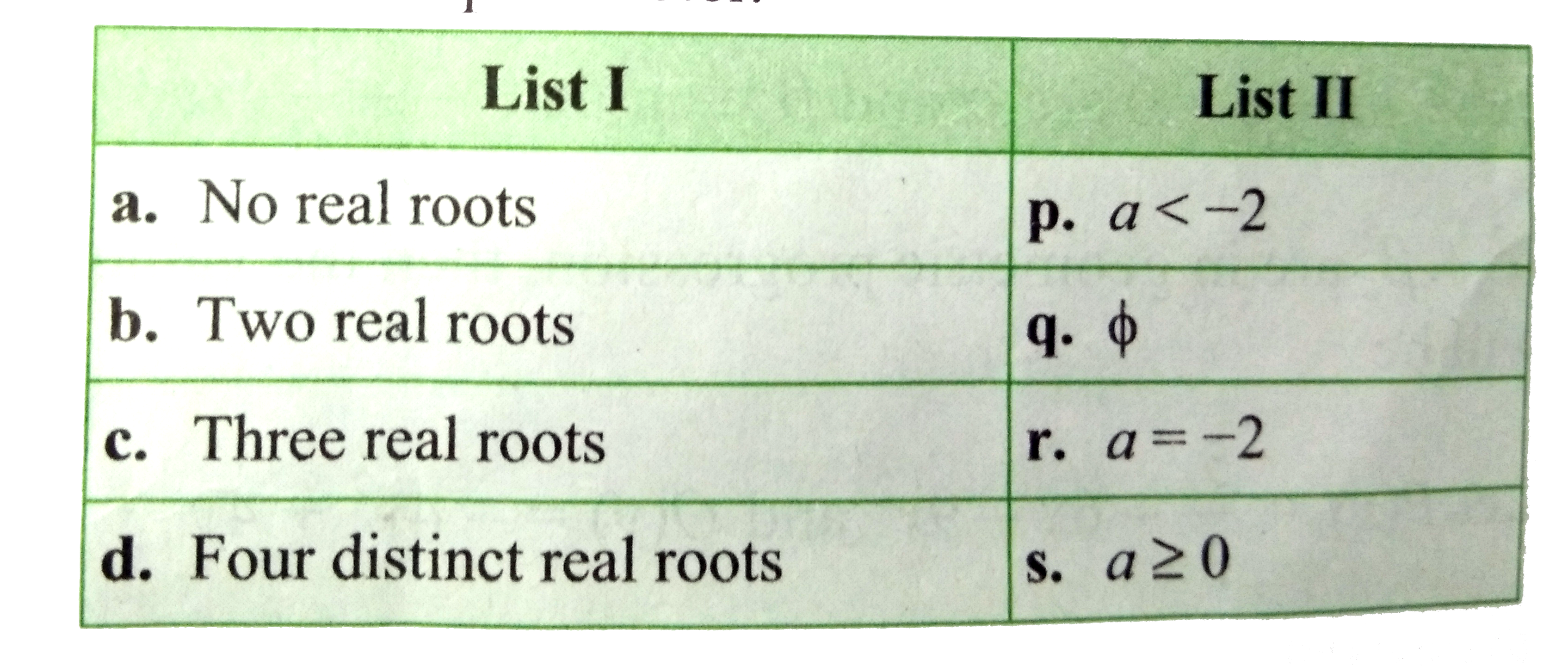Suppose a,b,c∈I such that the greatest common divisor fo x2+ax+bandx2bx+cis(x+1) and the least common ultiple of x2+ax+bandx2+bx+c is (x3−4x2+x+6). Then the value of |a+b+c| is equal to ___________.Solution in Tamil
The correct Answer is:6
x2+ax+b≡(x+1)(x+b)⇒b+1=a (1)
also x2+bx+c≡(x+1)(x+c)⇒c+1=b
or b+1=c+2 (2)
Hence b+1=a=c+2
Also (x+1)(x+b)(x+c)≡x3−4x2+x+6
⇒x3+(1+b+c)x2+(b+bc+c)x+bc≡x3−4x2+x+6
⇒1+b+c=−4
⇒2c+2=−4
⇒c=−3,b=−2anda=−1
⇒a+b+c=−6
Topper's Solved these Questions
- BOOK - CENGAGECHAPTER - THEORY OF EQUATIONSEXERCISE - JEE Main Previous Year7videos
THEORY OF EQUATIONS
- BOOK - CENGAGECHAPTER - THEORY OF EQUATIONSEXERCISE - JEE Advanced Previous Year9videos
THEORY OF EQUATIONS
- BOOK - CENGAGECHAPTER - THEORY OF EQUATIONSEXERCISE - Exercise (Matrix)6videos
THEORY OF EQUATIONS
- BOOK - CENGAGECHAPTER - STRAIGHT LINESEXERCISE - JEE Advanced Previous Year4videos
STRAIGHT LINES
- BOOK - CENGAGECHAPTER - THREE DIMENSIONAL GEOMETRYEXERCISE - Question Bank12videos
THREE DIMENSIONAL GEOMETRY
Similar Questions
If the roots of the equation bx2+cx+a=0 be imaginary, then for all real values of x, the expression 3b2x2+6bcx+2c2 is (1) greater than 4ab (2) less than 4ab (3) greater than -4ab (4) less than -4ab
07:47View SolutionQ. Let p and q real number such that p≠0,p2≠q and p2≠−q. if α and β are non-zero complex number satisfying α+β=−p and α3+β3=q, then a quadratic equation having αβ and βα as its roots is
01:04View SolutionMatch the following for the equation x2+a|x|+1=0 where, a is a parameter.
 04:57View Solution
04:57View Solutionabout to only mathematics
03:50View SolutionThe equation of the plane which has the property that the point Q(5,4,5) is the reflection of point P(1,2,3) through that plane, is ax+by+cz=d where a,b,c,d∈N. Find the least value of (a+b+c+d).
04:25View SolutionSuppose a,b,c∈I such that the greatest common divisor of x2+ax+bandx2+bx+cis(x+1) and the least common multiple of x2+ax+bandx2+bx+c is (x3−4x2+x+6). Then the value of |a+b+c| is equal to ___________.
02:11View Solutionthe greatest common divisor of x^(2)+ax+b and x^(2)+bx+c is (x+1), then -(A)a=c(B)2b=a+c.(C)a=c+2.(D)a+b=c+2
02:52View Solutionint(x+sqrt(1+x^(2)))^(n)dx=A(x+sqrt(1+x^(2)))^(n+1)+B(x+sqrt(1+x^(2)))^(n-1)+c then (1)/(A)+(1)/(B)=
07:16View SolutionIf a,b,c,x are all real numbers,and (a^(2)+b^(2))x^(2)-2b(a+c)x+(b^(2)+c^(2))=0 prove that a,b,c are in G.P.,and x is their common ratio.
04:17View SolutionIf equations x^(2)-3x+5=0 and (a+2)x^(2)-(b-1)x+c=0;a,b,c in N have a common root and c-a-b<=6 then possible value(s) of (a+b+c) is(are)
View SolutionIf greatest common divisor of x^(3)-x^(2)+px - 7 and x^(2)-4x +q is (x-1) , then the value of p^(2)+q^(2) is
04:33View SolutionIf x2+3x+5=0andax2+bx+c=0 have common root/roots and a,b,c∈N, then find the minimum value of a+b+c.
05:29View SolutionIf x2+ax+b=0andx2+bx+ca=0(a≠b) have a common root, then prove that their other roots satisfy the equation x2+cx+ab=0.
01:57View SolutionSuppose a,b,c∈I such that the greatest common divisor for x2+ax+b and x2+bx+c is (x+1) and the least common multiple of x2+ax+b and x2+bx+c is (x3−4x2+x+6). Then the value of |a+b+c| is equal to ___________.
01:28View SolutionIf ax2+bx+c=0 and bx2+cx+a=0,a,b,c≠0 have a common root, then value of (a3+b3+c3abc)2 is
05:36View Solution

